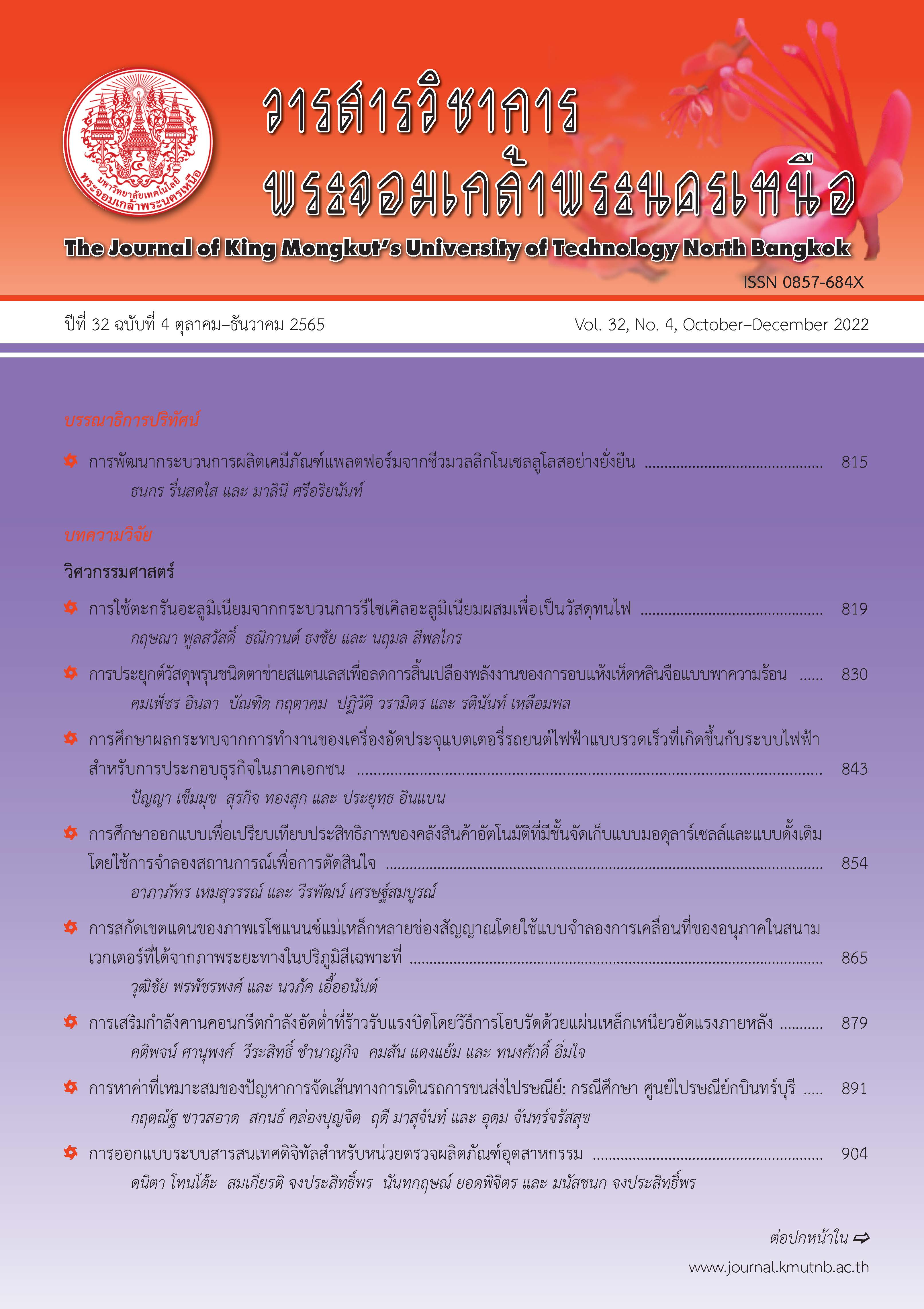พฤติกรรมทางทฤษฎีของการหล่อลื่นแบบไฮโดรไดนามิกของรองลื่นเพลากลมอากาศผสมฮีเลีย
Main Article Content
บทคัดย่อ
บทความนี้นำเสนอพฤติกรรมพฤติกรรมทางทฤษฎีของการหล่อลื่นแบบไฮโดรไดนามิกของรองลื่นเพลากลมอากาศผสมฮีเลียม ในสภาวะคงตัวสารหล่อลื่นที่เป็นอากาศและอากาศผสม เมื่อไม่พิจารณาผลการเปลี่ยนแปลงอุณหภูมิของฟิล์มสารหล่อลื่นที่อยู่ภายในรองลื่นเพลากลม โดยใช้ Finite Difference Method และ Newton Raphson Method แก้ปัญหาสมการโมดิฟายด์เรย์โนลด์ จากผลการจำลองพบว่าเมื่อเพิ่มอัตราส่วนผสมอากาศกับฮีเลียมและความเร็วรอบในการหมุนเพลา ส่งผลให้ค่าความดันฟิล์มสูงสุดกับค่าการเยื้องศูนย์สูงสุดมีค่าลดลง แต่ความหนาฟิล์มต่ำสุดและตำแหน่งมุมที่เกิดความหนาฟิล์มต่ำสุดมีค่าเพิ่มขึ้น ตรงข้ามกับเมื่อลดอัตราส่วนผสมอากาศกับฮีเลียมและความเร็วรอบในการหมุนเพลาลง ส่งผลให้ค่าความดันฟิล์มสูงสุดและการเยื้องศูนย์สูงสุดที่มีค่าเพิ่มขึ้น แต่ความหนาฟิล์มต่ำสุดและตำแหน่งมุมที่เกิดความหนาฟิล์มต่ำสุดมีค่าลดลง ส่วนการเปลี่ยนแปลงภาระที่เพลาได้รับเพิ่มขึ้น ส่งผลให้ความดันฟิล์มสูงสุดเพิ่มขึ้น แต่ความหนาฟิล์มต่ำสุดลดลง ให้ผลเหมือนกันกับสารหล่อลื่นที่เป็นอากาศและอากาศผสมฮีเลียม
Article Details

อนุญาตภายใต้เงื่อนไข Creative Commons Attribution-NonCommercial-NoDerivatives 4.0 International License.
บทความที่ลงตีพิมพ์เป็นข้อคิดเห็นของผู้เขียนเท่านั้น
ผู้เขียนจะต้องเป็นผู้รับผิดชอบต่อผลทางกฎหมายใดๆ ที่อาจเกิดขึ้นจากบทความนั้น
เอกสารอ้างอิง
W. A. Gross, Fluid Film Lubrication. New York: John Wiley & Sons, 1980.
K. S. Park, “The optimal helium fraction for air-helium gas mixture HDDs,” Microsystem Technologies, vol. 22, no. 6, pp. 1307–1314, 2016.
Z. Tang, P. A. S. Mendez, and F. E. Talke, “Investigation of head/disk contacts in heliumair gas mixtures,” Tribology Letters, vol. 54, no. 3, pp. 279–286, 2014.
C. Jonghak, “Analysis of thermal flying-height control for air-helium gas mixture in hard disk drives,” M.S. thesis, Department of Mechanical Engineering and the Graduate School, Yonsei University, Seoul, 2012.
S. Chotvisut, “Characteristic of lubrication in air thrust bearing with air-helium mixture,” M.S. thesis, Department of Mechanical Engineering Technology, College of Mechanical Engineering Technology, King Mongkut’s University of Technology North Bangkok, 2018 (in Thai).
G. A. Bird, Molecular Gas Dynamics and the Direct Simulation of Gas Flows, New York: Oxford University Press, 1994.
V.Casteli and J. Pirvics, “Review of numerical method in gas bearing film analysis,” Journal of Lubrication Technology, vol. 90, no. 4, pp. 777–790, 1968.
H. Zhang, C. Zhu, and Q. Yang, “Approximate numerical solution of hydrodynamic gas journal bearing,” in Intelligent Robotics and Applications. ICIRA 2008. Lecture Notes in Computer Science, Zhejiang, Springer-Verlag Berlin Heidelberg, 2008, pp. 260–268.
D. Sfyris and A. Chasalevris, “An exact analysis solution of the Reynolds equation for the finite journal bearing lubrication,” Tribology International, vol. 55, pp. 46–58, 2012.
A. Chasalevris and D. Sfyris, “Analytical evaluation of the finite journal bearing impedance forces using the exact analytical solution of the reynolds equation,” Journal of Vibration Engineering & Technologies, vol. 2, no. 5, pp. 423–432, 2014.
Y. B. Lee, H. D. Kwak, C. H. Kim, and N. S. Lee, “Numerical prediction of slip flow effect on gas-lubricated journal bearing for MEMS/MSTbased micro-rotating machinery,” Tribology International, vol. 38, no. 2, pp. 89–96, 2005.
B. J. Hamrock, S. R. Schmid, and B. O. Jacobson, Fundamental of Fluid Film Lubrication, 2nd ed. New York: Marcel Dekker, 2004.
N. Liu, J. Zheng, and D. Bogy, “Thermal flyingheight control slider in hard disk drives filled with air-helium gas mixtures,” in Applied Physics Letters, vol. 95, no. 21, pp. 213505– 213505-3, 2009.
H. Huang, G. Meng, and J. Chen, “Investigations of slip effect on the performance of micro gas bearing and stability of micro rotor-bearing systems,” Sensors, vol. 7, no. 8, pp. 1399–1414, 2007.

